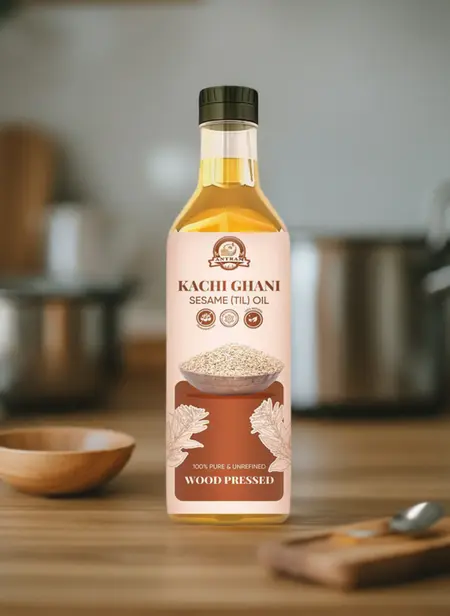What is difference between Wood Pressed oil vs Refined oil
Here’s a comparison between wood pressed oil and refined oil to help understand their differences:
1. Extraction Process
- Wood Pressed Oil:
Extracted using a traditional wooden press at low temperatures, without heat or chemicals.- Preserves natural nutrients, flavor, and aroma.
- No chemical refining or bleaching involved.
- Refined Oil:
Extracted using high heat and chemical solvents like hexane.- Undergoes bleaching, deodorization, and refining processes.
- Strips away nutrients and natural flavor.
2. Nutritional Value
- Wood Pressed Oil:
- Retains natural vitamins (like Vitamin E), antioxidants, MUFA, and PUFA.
- Contains no trans fats, promoting heart health.
- Refined Oil:
- Lacks essential nutrients due to the high heat and refining process.
- May contain trans fats, which are harmful to health.
3. Health Benefits
- Wood Pressed Oil:
- Promotes good cholesterol (HDL) and reduces bad cholesterol (LDL).
- Rich in antioxidants, supporting immunity and heart health.
- Free of harmful chemicals or preservatives.
- Refined Oil:
- Can raise bad cholesterol levels and increase the risk of cardiovascular diseases.
- May contain residual chemicals from the refining process, which can have long-term health risks.
4. Taste and Aroma
- Wood Pressed Oil:
- Retains the natural taste and aroma of the seeds or nuts used.
- Enhances the flavor of food.
- Refined Oil:
- Neutral taste and odor, achieved through artificial processing.
- Lacks the authentic flavor of the original seeds.
5. Shelf Life
- Wood Pressed Oil:
- Shorter shelf life due to the absence of preservatives.
- Best consumed fresh.
- Refined Oil:
- Longer shelf life because of added preservatives and chemical processing.
6. Environmental Impact
- Wood Pressed Oil:
- Eco-friendly, with minimal processing and waste.
- Promotes traditional and sustainable practices.
- Refined Oil:
- Requires industrial production, contributing to pollution.
- Generates chemical by-products.
Which is Better?
Wood Pressed Oil is the healthier and more natural option, perfect for those seeking a chemical-free, nutrient-rich alternative. While refined oil may be more readily available and have a longer shelf life, its lack of nutrition and potential health risks make it less desirable.
At Antram Foods, we believe to educate customers about the superior quality of your wood pressed oils! and benefit them from benefits of naturally processed unrefined wood pressed oil







